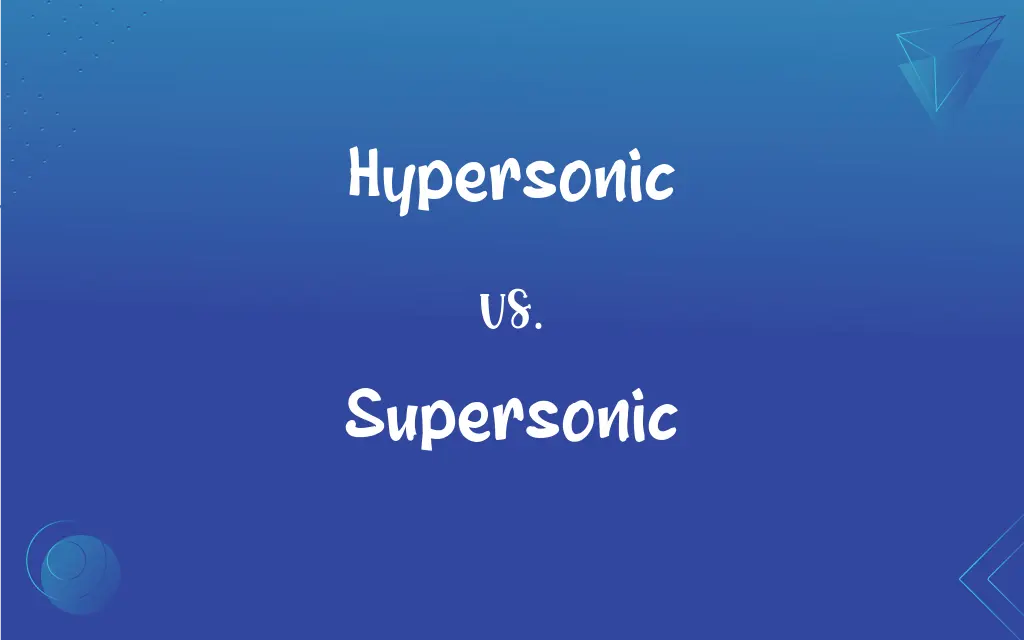Hypersonic vs. Supersonic: What's the Difference?
Edited by Harlon Moss || By Janet White || Updated on October 3, 2023
Hypersonic refers to speeds greater than Mach 5, while Supersonic denotes speeds exceeding Mach 1 but below Mach 5.

Key Differences
Hypersonic and Supersonic are terms primarily used in aerodynamics to describe specific speed ranges relative to the speed of sound. The speed of sound, referred to as Mach 1, is roughly 767 mph at sea level. Supersonic speeds are those that exceed Mach 1 but are less than Mach 5.
On the other hand, Hypersonic speeds begin from Mach 5 and extend onwards. At these speeds, air molecules react differently, causing changes in air density, temperature, and pressure. Thus, Hypersonic travel brings about unique challenges in design, thermal management, and materials when compared to Supersonic travel.
Supersonic speeds, though faster than the speed of sound, are now somewhat routine in aviation, especially in military jets. Sonic booms, which are loud noises resulting from shock waves, are a characteristic phenomenon of Supersonic flight. Hypersonic speeds, however, remain a frontier in aviation, with very few aircraft or missiles capable of sustaining such speeds.
In essence, while both Hypersonic and Supersonic pertain to high speeds, the former represents an extreme end of the spectrum. The technical and engineering challenges associated with Hypersonic travel are considerably more complex than those for Supersonic velocities.
Comparison Chart
Speed Range
Above Mach 5
Mach 1 to below Mach 5
ADVERTISEMENT
Technical Challenges
Extremely high
High but well-understood
Usage
Experimental aircraft, missiles
Military jets, some commercial flights
Aerodynamic Heating
Extremely high and challenging
Moderate
Sound Phenomenon
Creates shock waves
Produces sonic booms
Hypersonic and Supersonic Definitions
Hypersonic
Pertaining to extreme aerodynamic heating.
Hypersonic speeds result in intense heat on an aircraft's surface.
ADVERTISEMENT
Supersonic
Indicative of very fast or rapid actions.
His reflexes were Supersonic in the match.
Hypersonic
Relating to speeds of over Mach 5.
Researchers are testing new materials for Hypersonic flight.
Supersonic
Relating to speeds between Mach 1 and Mach 5.
The fighter jet can achieve Supersonic speeds.
Hypersonic
Denoting extremely rapid travel or projectiles.
The military developed a Hypersonic missile.
Supersonic
Faster than the speed of sound.
Supersonic flight became feasible in the mid-20th century.
Hypersonic
Indicating the frontier realm of aviation speeds.
Hypersonic research could revolutionize air travel.
Supersonic
Having, caused by, or relating to a speed greater than the speed of sound in a given medium, especially air.
Hypersonic
Concerned with the study of airflow at very high speeds.
He specialized in Hypersonic aerodynamics.
Supersonic
Of or relating to sound waves with a frequency above the range audible to the human ear; ultrasonic.
Hypersonic
Of, relating to, or capable of speed equal to or exceeding five times the speed of sound.
Supersonic
(of a speed) Greater than the speed of sound (in the same medium, and at the same temperature and pressure).
Hypersonic
Equal to, or greater than, or capable of achieving, five times the speed of sound.
Supersonic
Ultrasonic, having a frequency too high to be audible.
Hypersonic
Far enough above the speed of sound as to cause significant differences in behaviour due to chemical reactions or dissociation of the air.
Supersonic
An aircraft that can travel at the speed of sound.
Hypersonic
Pertaining to or moving at a speed greatly in excess of the speed of sound, usually meaning greater than mach 5. All speeds in excess of the speed of sound are supersonic, but to be hypersonic requires even higher speed.
Supersonic
Moving at a speed greater than the speed of sound in air; - this speed varies with altitude, since the speed of sound varies with altitude, as well as with temperature and humidity, being approximately 1129 feet per second at sea level and 984 feet per second at 16 miles altitude.
Supersonic
Capable of moving at speeds higher than the speed of sound; - of aircraft.
Supersonic
(of speed) greater than the speed of sound in a given medium (especially air);
A supersonic bomber flies so fast that it must release its bombs while the target is still over the horizon
Aircraft flying at subsonic speeds
Supersonic
Having frequencies above those of audible sound
Supersonic
Pertaining to or denoting sound waves with a frequency above human audibility.
Bats use Supersonic frequencies for echolocation.
Supersonic
Concerned with the aerodynamics of faster-than-sound speeds.
Engineers overcame many Supersonic challenges with the Concorde.
FAQs
Are all military jets Supersonic?
While many are, not all military jets are designed for Supersonic flight.
Why is Hypersonic flight challenging?
Hypersonic flight faces issues like extreme aerodynamic heating and air molecule reactions.
At what speed range is Supersonic flight?
Supersonic flight ranges from speeds above Mach 1 to below Mach 5.
Is commercial Hypersonic travel feasible?
Currently, it's mainly experimental, but there are hopes for future commercial Hypersonic travel.
What is the threshold for Hypersonic speeds?
Hypersonic speeds start from Mach 5 and above.
What are the applications of Hypersonic speeds?
They are mainly for experimental aircraft and high-speed missiles.
What causes the sonic boom in Supersonic flight?
It's caused by shock waves created when an object travels through the air faster than the speed of sound.
Did the Concorde fly at Hypersonic speeds?
No, the Concorde flew at Supersonic speeds.
What challenges do Supersonic flights face?
Challenges include sonic booms, fuel efficiency, and specific aerodynamic considerations.
Why aren't commercial flights typically Supersonic?
Factors include noise restrictions, fuel efficiency, and operational costs.
Are Hypersonic flights louder than Supersonic?
Both can produce intense noise, but the nature of the noise and its challenges vary.
What is the future of Hypersonic research?
The goal is to achieve efficient, safe, and commercial Hypersonic travel.
Are Hypersonic missiles in active use?
Some countries have developed and tested Hypersonic missiles, but their deployment is limited.
What does Mach 1 represent?
Mach 1 represents the speed of sound.
Why is heat a challenge for Hypersonic travel?
At Hypersonic speeds, the friction with the atmosphere results in extreme heating.
Are sonic booms dangerous?
While loud and potentially disruptive, they aren't typically dangerous to structures or people on the ground.
How do pilots handle Hypersonic speeds?
Hypersonic flights often require automated systems due to the speeds and reactions needed.
Are there any materials ideal for Hypersonic speeds?
Research is ongoing, but materials must withstand extreme heat and pressure.
Can Supersonic planes travel Hypersonically?
Typically, no. Supersonic planes aren't designed for the challenges of Hypersonic speeds.
Is there a term for speeds below the speed of sound?
Yes, it's called "subsonic."
About Author
Written by
Janet WhiteJanet White has been an esteemed writer and blogger for Difference Wiki. Holding a Master's degree in Science and Medical Journalism from the prestigious Boston University, she has consistently demonstrated her expertise and passion for her field. When she's not immersed in her work, Janet relishes her time exercising, delving into a good book, and cherishing moments with friends and family.
Edited by
Harlon MossHarlon is a seasoned quality moderator and accomplished content writer for Difference Wiki. An alumnus of the prestigious University of California, he earned his degree in Computer Science. Leveraging his academic background, Harlon brings a meticulous and informed perspective to his work, ensuring content accuracy and excellence.































































